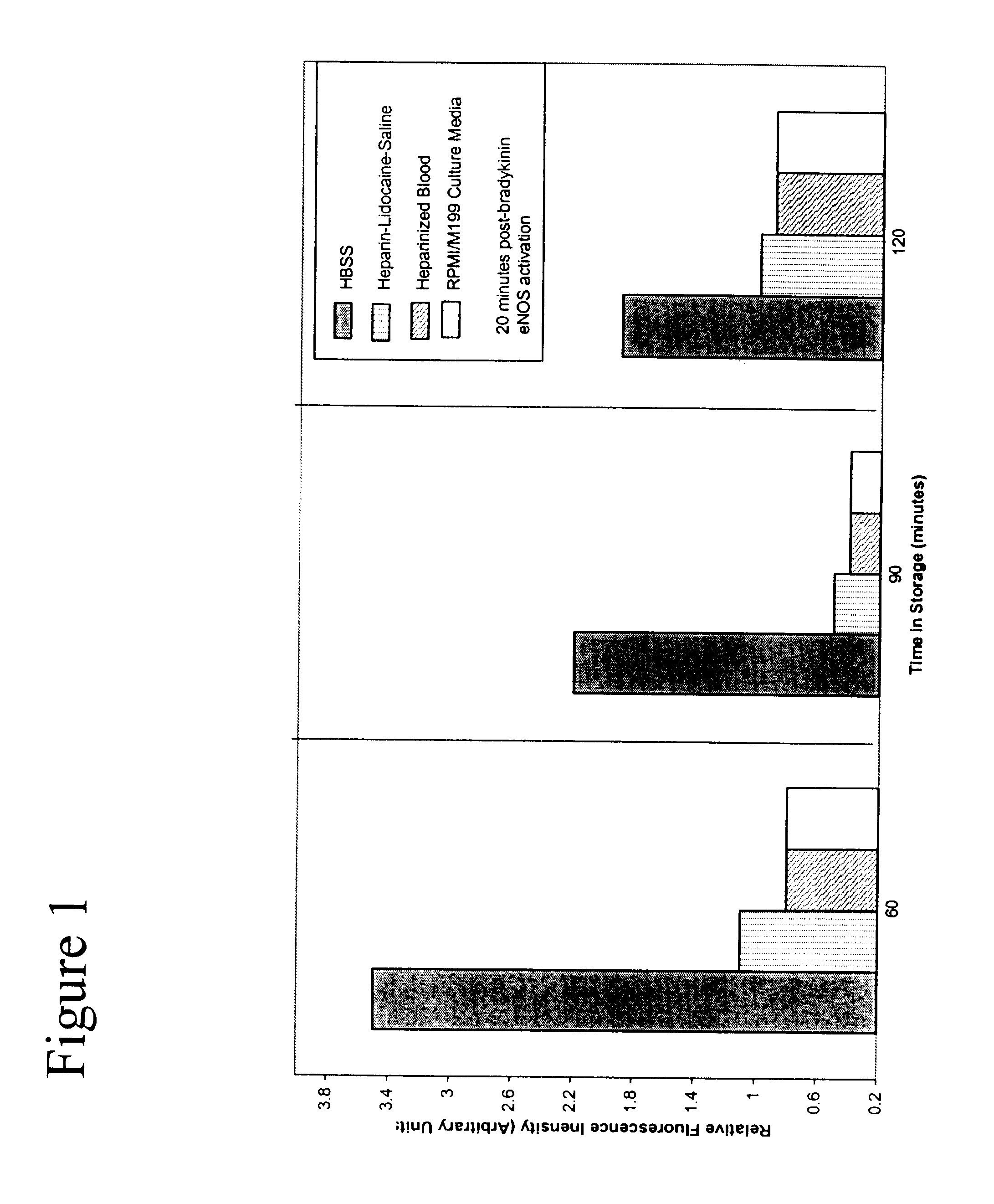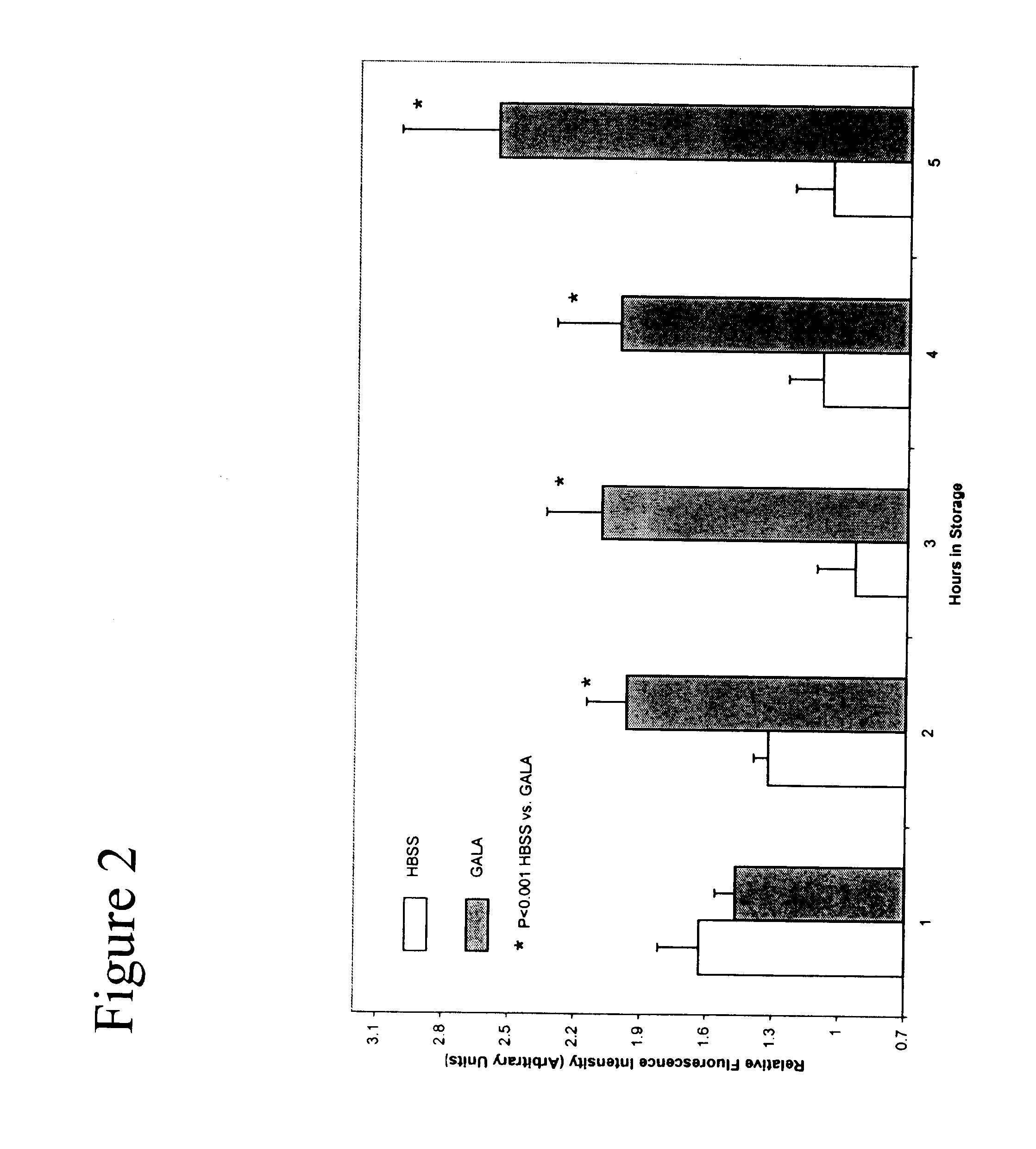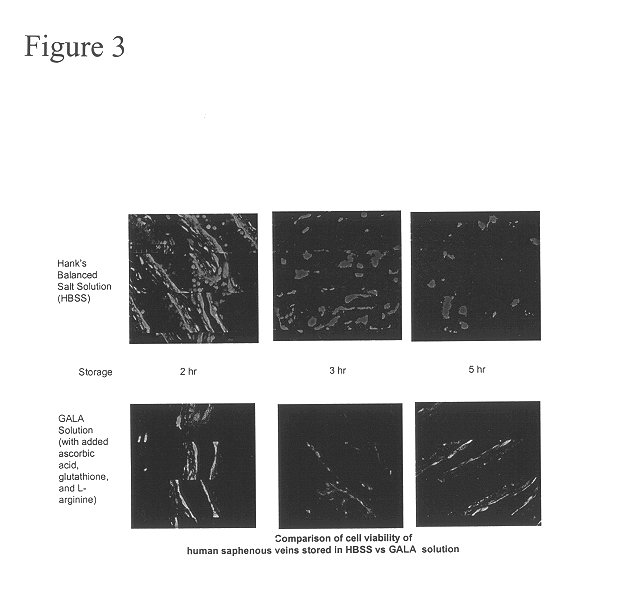Composition and methods for tissue preservation
a tissue and composition technology, applied in chemical methods analysis, artificial cell constructs, instruments, etc., can solve the problems that none of these solutions can preserve the structural integrity and function of saphenous vein endothelium for more than 2 hours, and achieve the preservation of structural integrity and function, simple preparation, and the effect of prolonging the viability of tissu
- Summary
- Abstract
- Description
- Claims
- Application Information
AI Technical Summary
Benefits of technology
Problems solved by technology
Method used
Image
Examples
example 1
Hank's balanced salt solution (HBSS), a commercially available physiological salt solution (Gibco / BRL, Grand Island, N.Y.) containing D-glucose 1 g / L, calcium chloride (anhydrous) 0.14 g / l, potassium chloride 0.4 g / l, potassium phosphate 0.06 g / l, magnesium chloride.6H.sub.2 O 0.1 g / l, magnesium chloride.7 H.sub.2 0 0.1 g / l, sodium chloride 8g / l, sodium bicarbonate 0.35 g / l, and sodium phosphate 0.048 g / l was modified by the addition of ascorbic acid (vitamin C), reduced glutathione, L-arginine, and heparin to a final concentration of 500 .mu.M, 1000 .mu.M, 500 .mu.M, and 50 Units / ml, respectively. The pH was then adjusted to 7.4 using 10 M sodium hydroxide. To date, no known preservation solution for harvested veins and arteries has been enhanced with ascorbic acid, glutathione, L-arginine, and heparin in an attempt to prevent endothelial injury. This new solution (known as GALA solution named after Glutathione, Ascorbic acid, L-Arginine) provides free radical scavengers, antioxida...
example 2
We next sought to improve further on the composition of HBSS by adding compounds with theoretical value in sustaining endothelial cell viability and cellular function. The end result was the GALA solution. An evaluation of the ability of HBSS and GALA solution to protect the endothelial cells during prolonged storage was then undertaken. The other three types of storage media were not tested under these prolonged conditions due to the lack of predicted eNOS activity and viability. FIG. 2 shows the effects on eNOS activity after 5 hours of storage in HBSS vs. GALA solution. Very little activity was noted in cells stored for 3, 4, and 5-hour exposures as compared to the 1 and 2 hour exposures for HBSS. In marked contrast, eNOS activity is sustained even after storage in GALA solution for up to 5 hours. The addition of ascorbic acid, glutathione, and L-arginine substantially prolonged the protection and functionality of the endothelial cells compared to the conventional HBSS solution (...
example 3
In order to elucidate the molecular mechanisms that are affected by the storage conditions, the vessel conduits were stored in HLS and GALA for 1-3 hours. Segments were then labeled with anti caveolin and anti eNOS antibodies and appropriate fluorescence tagged secondary antibodies. The immunofluorescently labeled vessels were imaged using the multi-photon imaging system. As shown in FIG. 5, both the caveolin and eNOS were robustly labeled with the antibodies in vessels stored in GALA for 3 hours. Furthermore, caveolin and eNOS colocalized on the plasma membrane of the EC. In contrast, these molecules were poorly labeled and did not colocalize in vessels stored in HLS. These results clearly demonstrate that GALA protected vessel endothelium at the molecular level, as cavolin and eNOS were maintained at their respective functional location seen in normal vessels. In contrast, HLS translocated these molecules to the nonfunctional interior regions of the EC and hence did not label well...
PUM
| Property | Measurement | Unit |
|---|---|---|
| diameter | aaaaa | aaaaa |
| temperature | aaaaa | aaaaa |
| depths | aaaaa | aaaaa |
Abstract
Description
Claims
Application Information
 Login to View More
Login to View More - R&D
- Intellectual Property
- Life Sciences
- Materials
- Tech Scout
- Unparalleled Data Quality
- Higher Quality Content
- 60% Fewer Hallucinations
Browse by: Latest US Patents, China's latest patents, Technical Efficacy Thesaurus, Application Domain, Technology Topic, Popular Technical Reports.
© 2025 PatSnap. All rights reserved.Legal|Privacy policy|Modern Slavery Act Transparency Statement|Sitemap|About US| Contact US: help@patsnap.com



